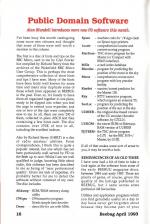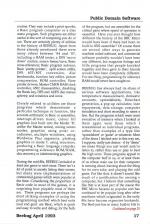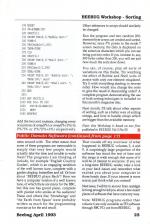Alan Blundell introduces more new PD software this month.
Public Domain Software
I've been busy this month cataloguing some more new releases and thought that some of them were well worth a mention in this column.
The first is a disc of hints and tips on the BBC Micro, sent to me by Glyn Fowler but compiled by Richard Sterry from the archives of the Wakefield BBC Micro User Group. This is perhaps the most comprehensive collection of short hints and tips I have seen. Many of the hints have been fairly well known for some time and many may duplicate some of those which have appeared in Beebug in the past. Even so, it's handy to have them all organized together in one place, ready to be dipped into when you feel the urge to extend your expertise, and one or two of the tips were completely new to me. In all, there are over 200 of them, collected in plain ASCII text files containing a few hints each. The disc contains over 270K of text in all, including the excellent indexes.
Also by Richard Sterry (G4BLT) is a disc of radio amateur utilities. From correspondence, I think this is quite a popular interest, but one which has not been particularly well served by PD on the Beeb up to now. Whilst I am not well qualified to judge, knowing little about radio, this software has been described to me as being of 'near professional quality'. Given my lack of expertise, it's probably better for me to detail the software without comment of my own.
The disc includes:
Alldump ROM/RAM memory dump utility
CW/gso CWtransceive program. Needs simple tone decoder.
Demo Demo file for use with Mfile.
Epson Machine code for */# sign clash on Epson-type printers.
Locate Comprehensive locator and contest scoring program.
MasTerm TNC driver program for the Master (or Compact with R5423 interface).
Mfile A card-index database
Moonloc Program for predicting the position of the moon in the sky.
Morse Comprehensive morse-tutor program with key practice facility.
RiseSet Sunrise/sunset predictor for the Master 128.
Rtty RTTY transceive program, which requires an external TU.
SunLoc Program for predicting the position of the sun in the sky.
UUBEEB The original disc-based version of the UU encoder/decoder software, by G7GLN.
UUROM The newer ROM or Sideways RAM version of UUBEEB
PJJTERM The TNC driver program (v3.37) for the BBC B/B+/Master, by G1PJ.
If all of that makes some sort of sense to you, it may be worth a look.
Reminiscences Of An Old Timer
I have now had a bit of time to take a look again at the software from some of the early Beebug magazine discs, between 1984 and early 1987. There are plenty of gems, of course, given the quality of the listings published in Beebug, but I came across some particular old favourites.
Utilities and application programs which you find genuinely useful on a day-to-day basis never get forgotten about because they become part of your routine. They may include a print spooler, a Basic program compacter or a disc menu program. Such programs are either useful in the sort of computing you do or not. There are certainly plenty of utilities in the history of Beebug. Apart from those already mentioned there were many others between '84 and '87, including a RAM tester, a DFS 'move down' routine, screen freeze/save, Basic cross-referencer, Basic program autorun, Basic 'pretty-printer', split screen utility, DFS 40T/80T conversion, disc benchmarks, function key editor, picture compression, ROM controller, View printer drivers, Master CMOS RAM clock controller, 6502 disassembler, disabling the Break key, DFS and ADFS disc menus aplenty; and windows and icons.
Closely related to utilities are those programs which demonstrate a particular technique or function, like accurate arithmetic in Basic or assembler, interrupt-driven music, colour fill graphics (not built into the Model B, unlike the Master series), mixing screen modes, graphics using polar co-ordinates, multiple windows, using Wordwise Plus segments, plotting graphics in mode 7, using recursion, producing a Basic language compiler, programming sideways ROM/RAM, disc recovery or inbetweening graphics.
During the mid-80s, Beebug included at least one game in each issue. There isn't a lot of point in merely listing their names, but many were implementations of commercial games which were popular at the time. Considering the proportion of Basic code in most of the games, it is surprising how playable most of them are. These programs are perhaps the most striking examples of using the programming method which best suits your end goal: use Basic, which is quick and easy to write and debug, for the bulk of the program, but use assembler for the critical parts where speed of operation is essential. Have you ever thought how different the history of the BBC Micro would have been if there had been no built-in 6502 assembler? Of course there are several other ways to generate machine coded software, and commercial software probably wouldn't have been any different, but magazine listings and little programs that people knocked together and then gave to their friends would have been completely different. For one thing, programming for sideways RAM would never have caught on.
Beebug has always had its share of serious software applications, like temperature measurement, domestic accounts, spreadsheets, flowchart generation, a pop-up calculator, loan repayments, data storage, computer simulation and chart recording to name a few. But the programs which were most evocative of memory when I looked at them again were those which I remembered as individual programs, rather than examples of a type like 'spreadsheet' or 'game' or whatever.
Most of the items I latched onto in this way are, I suppose, really just demos - if by 'demo' we mean things you just watch and/or listen to, rather than use or play to beat the high score. These programs appeal to the computer buff in us, or at least those of us whose main use for their computer is messing about, learning about the thing for its own sake, and playing the odd game. Put like that, it doesn't sound like much of a justification for owning a computer, but I believe that something like that is at least part of the reason the BBC Micro became so popular and has continued to be popular long after other machines which originated in the early 80s have become expensive bookends.
The Beeb just has so many built-in bits to mess around with. The other reason that some of these programs are memorable is simply that very few people would actually take the time and trouble to write them! The programs I am thinking of include, for example 'English Country Garden', which is an engaging rendition of the well known tune, complete with a garden display, butterflies and all. Or how about 'Beebug plays Bach'? Here we have a computer version of a well known tune, of which there are many for the BBC, but this one has grand piano, complete with pianist who smiles at his audience!
These and others like 'Stonehenge' and 'The Earth from Space" were probably written as much for the programming exercise as for the end result.
That rounds off my overview of what happened in Beebug volumes 3, 4 and 5. A surprisingly large proportion of the software has stood the test of time and the range is wide enough that some of it will be of interest to everyone. If you are a long-time Beebug reader, take a look at your back issues and remember what excited you about your computer in those heady days. If your interest is more recent, just think what you missed!
Next issue, I will try to recover from nostalgia for long enough to tell you about a few recent pieces of software that have come my way.
Note: Beebug programs earlier than volume 6 are only available as PD software through BBC PD, not from Beebug.
This article was converted to a web page from the following pages of Beebug Volume 11 Number 10.


 1st April 1993
1st April 1993


